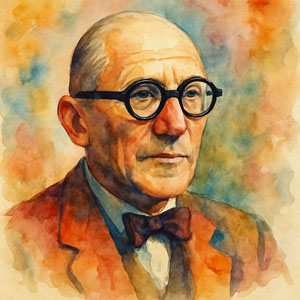 The bold, passionate visionary of modern architecture and urban design, Le Corbusier (1887–1965) was born Charles‑Édouard Jeanneret‑Gris on this day in Switzerland’s watchmaking city of La Chaux‑de‑Fonds. He later adopted the name “Le Corbusier,” inspired in part by his French maternal heritage.
The bold, passionate visionary of modern architecture and urban design, Le Corbusier (1887–1965) was born Charles‑Édouard Jeanneret‑Gris on this day in Switzerland’s watchmaking city of La Chaux‑de‑Fonds. He later adopted the name “Le Corbusier,” inspired in part by his French maternal heritage.
An accomplished painter and draftsman, he quipped, “I prefer drawing to talking. Drawing is faster, and allows less room for lies.” He championed simplicity and light, imagining vertical cities of slender towers to open generous ground for parks, gardens, and play: “sun, space, and silence,” a radiant city of joy.
“The materials of city planning are: sky, space, trees, steel and cement; in that order and that hierarchy,” he wrote. His buildings embraced double‑height rooms, modular proportion, and prefabrication, marrying innovation with the timeless lessons of antiquity and the classical Mediterranean. “Architecture… a habit of mind, not a profession.”
In 1951 he guided the plan for Chandigarh, the new capital of India’s Punjab—ordered sectors, broad pedestrian ways, reflective pools, and sculptural civic structures. His pilgrimage chapel of Notre-Dame-du-Haut at Ronchamp (1950–1955), in eastern
Ever the synthesist, he affirmed, “Architecture is the learned game, correct and magnificent, of forms assembled in the light,” a vision where form, space, heart, and spirit meet in harmony.
 Make your home a living treasure chest. 🏡
Make your home a living treasure chest. 🏡 